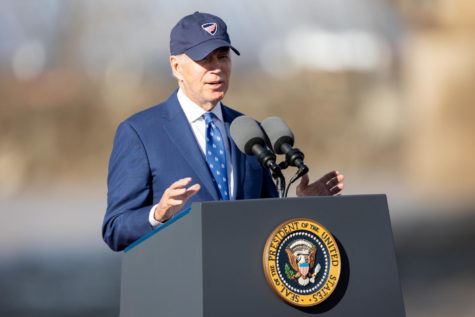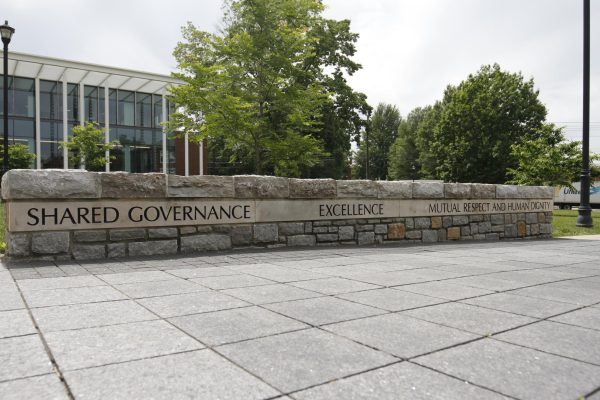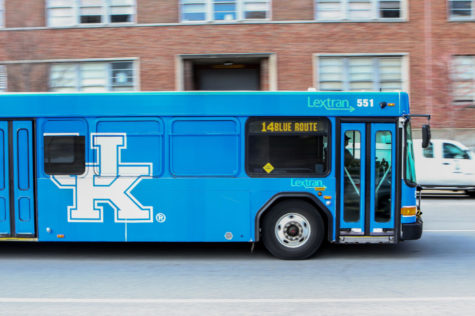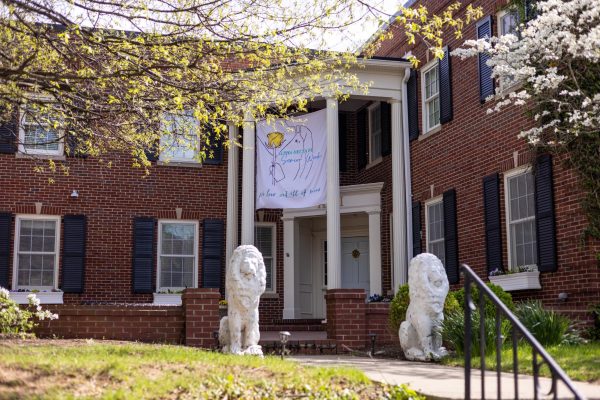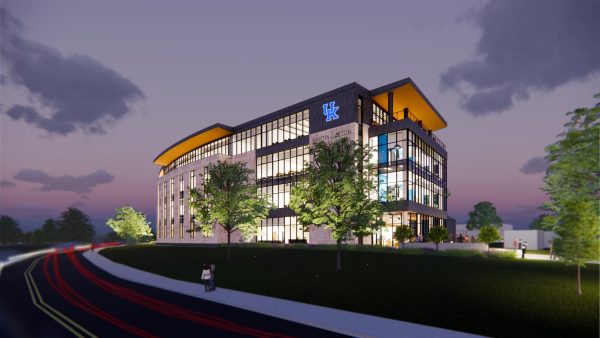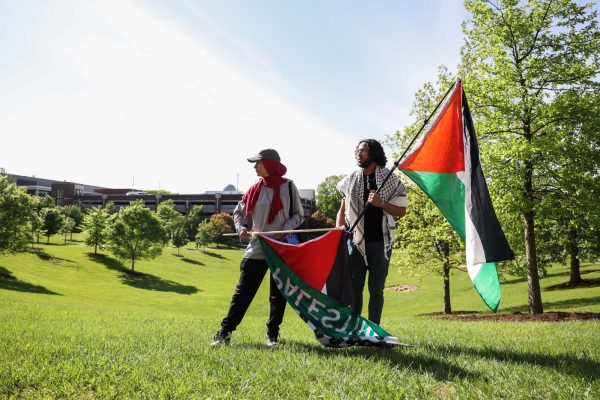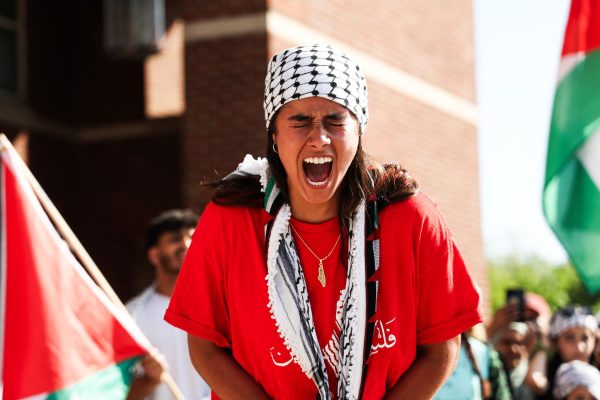Lexington’s protests have been mainly peaceful. Why?
Protesters hold up signs in downtown Lexington on Sunday, May 31, the third day of protests in Lexington against police brutality and racism in solidarity with movements across the country. Photo by Sydney Carter.
June 10, 2020
Lexington protesters have marched in the streets for 13 consecutive nights as part of a nationwide pushback against policy brutality against black Americans. The protests were sparked by the murder of George Floyd, a Minneapolis resident, and quickly spread across the country.
In some cities, protesters and police have had violent clashes that have resulted in serious injuries. Though increasingly common across the country, Lexington protests have not seen that kind of escalation and instead remained peaceful.
Over the previous 12 nights of protests, protesters have mostly marched and chanted through downtown streets. The Lexington Herald-Leader described protesters as kneeling and even praying to show what they stand for, and often conversing with police officers. The Herald-Leader also reported that there were few incidents of property damage, unlike the recent widespread looting and vandalism seen in cities like Washington D.C. and Louisville.
The number of total arrests from Lexington protests still remains in single digits, out of thousands of arrests across the country.
The peaceful atmosphere could be attributed to many factors, including the Lexington police department’s relationship with the community, the group policing themselves and the leadership of public officials.
Lexington police have on multiple occasions at the protests knelt, walked or prayed with protesters. However, the police department itself has a complicated history with racial issues.
In 1994, 18-year-old Antonio Orlando Sullivan from Lexington was killed after hiding in a closet in his room from police who were serving a warrant. The police chief at the time, Larry Walsh, said the shooting happened after Sullivan had entered the living room to respond to officers and an officer’s weapon was accidentally discharged, shooting Sullivan in the head. Sullivan’s death sparked riots in downtown Lexington, injuring several people.
African American sworn-in personnel currently make up only 8.2 percent of the Lexington police department. Hispanic personnel account for only 2.6 percent of the department, while Caucasian sworn personnel have a sweeping majority with 89.8 percent.
According to data from the Lexington police department’s Public Integrity Unit, in 2019, there were 10 reports of racially-motivated bias complaints as well as 184 complaints against officers’ responses to resistance, including complaints of excessive force. As of May 2020, there have been two reports of racially-motivated bias complaints as well as 72 complaints against response to resistance so far this year.
However, some Lexington citizens and protesters attribute the peacefulness of the protests to the overall cooperation and understanding of law enforcement in the community.
“The police officers here in Lexington have really been showing their support as well and showing that they are noticing that we are doing this peacefully, and we don’t want a big riot,” Maria Edwards, a Lexington resident and protester, said. “It does make that a lot better and a lot easier for us to be out here and to do that when we have that support, which I’m really happy Lexington does have.”
Police across the nation have been accused of inciting and causing violence at these protests by using excessive force such as tear gas, rubber bullets, batons, tasers and other weapons against peaceful protesters, pedestrians and journalists. Examples of this escalation have swarmed social media in the past week, including a New York police department cruiser driving into a crowd of protesters and a video of police in Buffalo shoving a 75-year-old protester to the ground and leaving him in serious condition.
“For one thing, I think the police have done a much better job in Lexington than they have in some other places. I think that they have been a pretty fair police force comparatively speaking to other towns,” said Chris Herman, a participant in last Monday’s protest.
But as relationships between local police departments and protesters have become increasingly fraught in many places, protesters and officers in Lexington have maintained relative calm. Lexington officers have knelt, marched, hugged, prayed and even played rock, paper, scissors with protesters. Beginning on Thursday, officers went without riot gear for the night and were encouraged to have conversations with community members.
“I think that people believe that when they’re calling the police, they’re actually coming to help them in this town. So I think there’s a little more trust here than there is in some other places,” Herman said.
On May 31, the night with the biggest crowd of protesters, the police reported zero arrests. Officer Megan Padgett came in on her day off to help work the protest.
“We actually had some very decent conversations with several people even though obviously it’s a lot of people and with your gear on it’s kind of hard to hear but I mean, it was a pretty good night overall,” Padgett said.
Other participants say the protests have been peaceful because the protesters themselves have been active in promoting that atmosphere and correcting those who step out of line.
“I mean, it could just be the officers down here, it could be the people,” Padgett said. “There’s a lot of obvious factors involved but I mean I’m glad it’s been peaceful, everybody here has been really I guess organized and very good about wanting to be peaceful here.”
Padgett said something as simple as throwing a water bottle warranted disapproval from the group and the antagonist being cut off from other protesters.
At multiple points during last Monday’s protest, a small faction of the group tried to antagonize police by jumping on cop cars or screaming in officer’s faces. However, these actions were met with a yell to stop and move on from the majority of the group.
“Don’t give them a reason to attack us,” yelled one protester at the antagonists.
Kaulbert Wilson, one of the de facto leaders of last Monday’s march, said the group’s peacekeeping is helping relay their message.
“We’ve all been peaceful, but for us to actually have officers walking with us, we’ve spoke and they’ve heard. So therefore, this: officers following us, that should mean something to them,” Wilson said.
Wilson was detained by police at Sunday’s protest and arrested later on Monday night and charged with disorderly conduct, inciting a riot, assault in the fourth degree (no visible injury) and evading police. He was also involved in an altercation with a civilian during another night of protests.
Jana Warfield, a protester and mother, said this peaceful atmosphere allows her to feel safe enough to bring her 2-year-old son to show him how important it is to use his voice.
“So I’m not trying to do all that crazy stuff. But peaceful, I’m with it,” Warfield said.
Some have attributed the peaceful atmosphere to the actions of public officials like Mayor Linda Gorton or Lexington Police Chief Lawrence Weathers.
During the May 31 protest, Mayor Gorton went out to speak to those protesting in the Courthouse Plaza.
“I went downtown to listen to our citizens… that’s a first step. Now we’re taking the next step… starting a community conversation about how we go forward, together,” Gorton said in a tweet on Monday.
Mayor Gorton has also been vocal about making necessary changes to the Lexington police department. Gorton said later in a tweet that she would be creating a group consisting of citizens, court representatives, members of the faith community, the Urban County Council and other groups to recommend what changes needed to be made.
“In Lexington, demonstrators have peacefully let our City know they are hurting. The moment is now … it is time to listen to the voices of so many,” Gorton said in the tweet.
Chief Weathers’s behavior and mindset may also play a role in the peaceful demeanor of the protests.
In a press conference on June 1, Weathers said he encouraged his officers to do what they feel is right when it came to kneeling with protesters on Sunday night. Weathers said he was among the first officers to kneel along with protesters.
“As the chief, it’s my job to let the officers know what’s appropriate and what’s not,” Weathers said. “I told them, ‘If you want to kneel, kneel. It’s your choice.’ ”
The actions of the chief and LPD officers are in stark contrast to those of police in Louisville, where the National Guard has been deployed and police have used tear gas, rubber bullet, and pepper balls against protesters in the streets. Tensions between protesters and police increased following the shooting of David McAtee by the National Guard in the first five days of protesting.
The most extreme measure protesters have seen from Lexington police is the installation of a railing to keep protesters from being face to face with the officers. One officer was said to make protesters uncomfortable, but Chief Weathers since removed that officer.
As protests in Lexington approach their second week, each of these factors have contributed to a mostly peaceful atmosphere in downtown Lexington and continuing this peace will rely on the cooperation of police, protesters, and local officials as the community moves towards addressing protesters concerns and demands.










































































































































